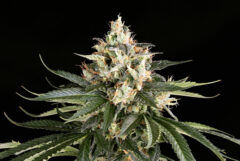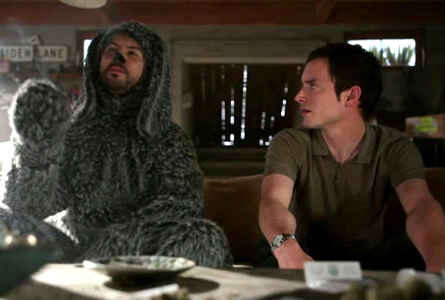Governments and mainstream public opinions may be working on a slow learning curve in regards to the cannabis topic, but this is far from being the case on the pop culture front. The movie industry has been giving a face to cannabis consumers for decades, with (more or less) accuracy:
Governments and mainstream public opinions may be working on a slow learning curve in regards to the cannabis topic, but this is far from being the case on the pop culture front. The movie industry has been giving a face to cannabis consumers for decades, with (more or less) accuracy: whether they are gratuitous but valuable guest stars, or accessories to bringing the “cool” factor often associated with cannabis, enthusiasts of the plant have succeeded in becoming useful tools to cinema writers.
Lately, cinema has taken a bit of a backseat when it comes to being avant-garde, partly due to the recent revival in English-speaking fiction television, whether it originates from Hollywood or elsewhere.
Perhaps this phenomenon has to do with the ruthless marketing strategies that come with the movie industry nowadays, that are often solely based on a proper targeting of the most desired audience, missing many other demographics in the process.
Perhaps it is just that, to get to know characters, as one would if reading a novel saga, viewers need to build a long term relationship with them. And this might be precisely what fictional cannabis consumers need: a wide range of open-minded average people willing to get to know them.
The 1990s – Witch Hunters VS Potheads
Cannabis on television during the nineties marked the beginning of a change in the game.
The cultural landscape of the first half of the decade was decidedly built on the same model as the previous one, at least when it came to the role and importance of television in society, and the messages that can be broadcast through it. Thus, the traditional “cannabis episode” was the epicentre, if not the only, occurrence of marijuana on television; and was generally a proud flag for the glory of D.A.R.E. and to the war on drugs.
Every single teenager born in a sitcom family had their parents suspiciously investigate them following the shocking finding of a cannabis cigarette, from the very proper Cosby Show, to the more working-class-oriented Roseanne. However, the latter dared a twist in their otherwise overused story; the cannabis found was in fact the parents’.
During the second half of the nineties, more “daring” TV series of the kind that leads the market nowadays started to fill up schedules, next to politically correct, if not conservative, shows.
The overall result has a borderline hilarious aftertaste of “will they, won’t they”. Will they finally accept that cannabis is not more dangerous than alcohol?
According to the irreverent youngsters of That ‘70s Show, that is a definite yes. Of course, one could argue that the premise of the show (it takes place during the seventies) justifies the lack of taboo on the marijuana question. Regardless, while practically omnipresent, cannabis use is portrayed as a spiritual refuge for the protagonists of this coming-of-age hippie story, rather than a rebellious, self-destructive operation. 99.5% of the storylines have nothing to do with cannabis, and are never affected by it – the remaining .5 having something to do with the parents occasionally wondering what goes on in their basement. It is worth mentioning that this has been accomplished without once showing a single gram of cannabis on screen, and by giving actor Tommy Chong (Cheech & Chong) the recurring role of an ageing, careless but wise hippie; indisputably, the work of inspired cannabis sympathisers.
The other side of the smoke cloud, however, shows a very different take on the young cannabis user. In 1997, barely a year before That ‘70s Show aired its first episode, the family show 7th Heaven was addressing the issue in a slightly more dramatic way. Joints were brandished, characters stormed out of numerous rooms, symphonic orchestras performed their best rip-offs of the Jaws soundtrack. Again, context partly explains this; the show depicts the story of Reverend Camden and his family after all. Regardless, the mise-en-scène is beyond ludicrous, to a point where one could very well substitute crack or heroin for cannabis to justify the general “highway to hell” mood of the episode. A bit of a let-down from a TV series that tackled other sensitive society matters such as teen pregnancy, alcoholism, or bullying, with relative panache. This example tends to demonstrate how certain things can be perceived as dangerous and corrupted due only to their illegality, by the establishment and the people who trust it.
The 2000s – Trends and fashions
The 2000s are a goldmine of tiny, discreet contributions from the television industry to the cannabis world.
Not unlike That ‘70s Show, TV series adopted cannabis as merely a basic parameter in the life of their characters, with a profound disregard for the frequency of its occurrence, that is, as life often works out depending on what kind of consumer one is.
Many writers of television shows now considered mainstream have taken liberties with their characters’ hobbies, and it appears banalities made up by modern marketing such as “stiletto stoners” or “successful potheads” may have had an impact on their decision to do so.
For instance, the ladies of Sex and the City (1998 – 2004) seem to put themselves into interesting states quite often, with the help of gentlemen-induced blues, and cannabis. And yet, Sex and the City has no such thing as the “cannabis episode”; the writers chose to show the plant as an integrant part of the daily life of these highly functioning professional women – a writer, a publicist, a lawyer, an art dealer, all of them very successful in their respective fields. Cannabis is, in fact, mentioned only twice during the entire series run, proof that there is no essential need to dedicate epic storylines to a cause that could sometimes do with being less epic in portraying the consequences of war on drugs. Series such as Californication (2007), Six Feet Under (2001), and Entourage (2004) also show this side of recreational consumption, although their vision of being a successful, highly functioning professional is debatable. The TV series Mad Men, which aired first in 2007, and carried on to become one of the most appreciated period dramas of the decade, also gives increasing screen time to cannabis. The last season, which started in April 2014, had its premiere episode show Don Draper, one of the most iconic characters of the show, casually lighting up with his spouse on the beach.
The British teen drama Skins (2007) probably made the boldest of moves in the general direction of casual consumption of cannabis. Not only the name – “skins” is a reference to a British slang word for “rolling papers” – but also nearly all of its characters partake in the plant. Admittedly, the teenagers also consume many other drugs, but cannabis, while flowing freely, is rarely mentioned, and is never anywhere close to being linked to the dangerous behaviours shown. It is however often used as an accessory to reflection, in particular during times of grief and disarray.

And in the domain of crossing the barrier from engaged entertainment to downright activism, the TV series Weeds (2005) takes the cake, by depicting the struggle of a single mother and her choice to illegally sell cannabis to make ends meet, for a grand total of eight seasons.
The series is not necessarily considered a classic by the cannabis community, but still has the merit of being an eye-opener for those who still believe in the war on drugs and in the integrity of the pharmaceutical drugs industry.
Finally, there are many other characters from TV series which aired during the 2000s, who, over years of broadcast, have been delivering confusing one-liners or significant looks that leave close to no doubt regarding their status of closet potheads.
While some would appreciate more visible efforts, these characters are realistic representatives for all the invisible cannabis consumers out there, and the seeming randomness of these discreet outings could make them even more accurate.
The 2010s – Normalization
There are now several places in the world where consuming cannabis is socially accepted, and in some cases, legally so too. In pop culture terms, this means that cannabis might be close to reaching its mainstream status before it becomes legal on a global scale. Going the extra mile to claim one’s affiliation with the cannabis world does not seem that necessary anymore, which could be the reason why references to it might be less “indie” than what the viewer has been used to.
Notwithstanding, the introspective nature of the human mind when under the influence of cannabis is a major storyline of the American remake of the show Wilfred (2011). The main character, Ryan, is depressed and suicidal, and is the only person who sees his neighbour’s dog, Wilfred, as a man wearing a dog suit. Unemployed, he spends most of his days in his basement smoking cannabis with Wilfred, and wondering, along with the viewer, what is wrong with him, and who the man-dog really is. A manifestation of his own mind? A supernatural occurrence? An actual man in a dog suit? Cannabis is definitely a parameter in this story, as a mind-enhancer and as an anti-depressant. Wilfred may be among the most baffling, albeit realistic, content made for television that ponders on the human psyche.
Melissa & Joey (2010) and Last Man Standing (2011) both respected the family sitcom tradition of tackling the cannabis monster. In the former, the least commendable teenager of the bunch gets suspended from school for having smoked cannabis. But in a somewhat strange turn of events, after a couple of well-worn stoner puns and a generally nonplussed reaction by the parental figures, the plot carries on in another direction. Admittedly, this is not exactly an homage to the cannabis cause. However it tends to prove that while US rules remain the same, at least in most states, mentalities on the other hand, while ever law-abiding, have dramatically changed. Even the Colorado-based Last Man Standing managed to give its sexist, politically conservative, traditional main character a father who decides to open a marijuana store, for which he grows himself.
Moreover, a return of the stereotypical stoner can be observed in the larger world of sitcoms. The characters of Victoria from Mike & Molly (2010), Deke from 2 Broke Girls (2011), Nolan from Anger Management (2012), everyone from Workaholics (2011); all of them are textbook cases of the Cheech and Chong syndrome. Nevertheless, for each of the aforementioned, the respective writers seem to have made the effort of handling a reasonable amount of character development, freeing their creations from the cliché of cannabis consumption being sufficient as a sole defining parameter.
Another benefit of the normalization of cannabis on television is that, while cinema seemed to have assigned cannabis consumption in most part to giggly, ever so slightly lazy men, the television industry chose to disagree with altogether ignoring women consumers. Besides the examples already mentioned, the shows Girls (2012), and the very recent Broad City (2014) show women who consume cannabis regularly, while representing a more than attainable demographic of the female population: imperfect women. A refreshing view on the female stoner to counter the usual “manic pixie stoner dream girl” fantasy.
Television may still appear to some as a second-class source of entertainment, but its efficiency in decoding current societal topics is sometimes greater than observed through other mediums considered more artistically valuable.
Sensi Seeds hopes that one day, cannabis consumers will be able to casually roam public and private channels alike, and that smoking cannabis will stop being a defining parameter for all the enthusiasts of the plant everywhere in the world, whether they are fictional or not.


















